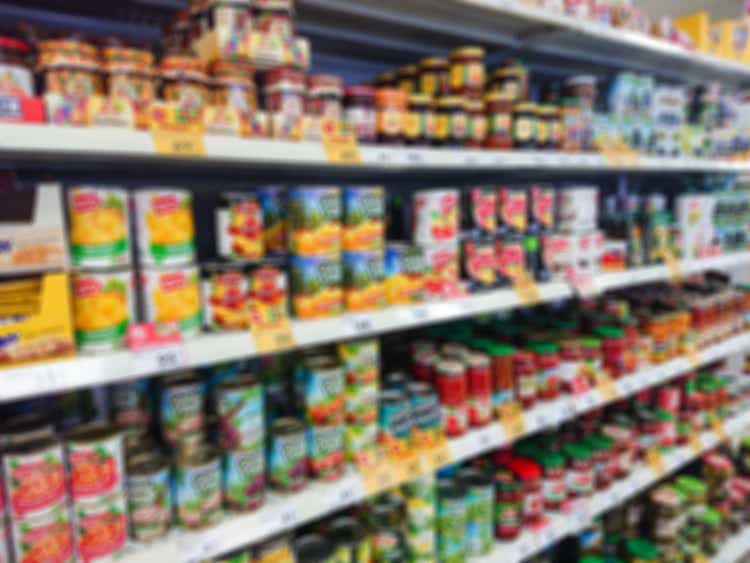lapandr/iStock via Getty Images
Shares of B&G Foods (NYSE:BGS) have seen a pullback in recent times amidst concerns about raging cost inflation, and hence likely pressured results in the near to medium term.
My last take on B&G dates back to the summer of 2021, as I concluded that B&G was a continued leverage story. The company was struggling with declining base/organic sales declines ahead of the pandemic, as the outbreak of the Covid-19 virus was actually a life savior. With the company using the increased earnings power to reduce leverage, I was leaning cautious.
Former Take
B&G is an interesting smaller to medium-sized food player, as B&G combines high leverage ratios with a high dividend yield, quite a stubborn strategy if you ask me. This comes as management has M&A ambitions, a dividend commitment and growth ambitions, as there were many capital allocation goals of management which can not all be fulfilled at once.
Ahead of the pandemic, B&G was a near $1.7 billion business which generated some $300 million in EBITDA, as a $1.9 billion net debt load translated into a >6 times leverage ratio. At the same time, earnings power of around $1.75 per share worked down to very low valuation at high single digits. Yet, with a dividend of $1.90 per share only increasing leverage, while base sales were under pressure, I feared that management would only act too late.
Following the outbreak of the pandemic, the company saw a boom in sales with first quarter sales in 2020 being up 9%, as second quarter sales rose as much as 38%. Moreover, earnings power improved spectacularly and leverage came down, with management quickly using the improved position to announce a $550 million deal for baking products business Crisco in October.
While third quarter sales growth slowed down 22%, and sales only increasing 8% in the fourth quarter, it still was a great year. After all, sales nearly came in at $2 billion, EBITDA came in 20% higher than guided for as well at $360 million, as adjusted earnings rose to $2.26 per share. The issue is that the Crisco deal resulted in net debt of nearly $2.3 billion, as leverage ratios of 6.3 were the same as the start of the year. This is certainly the case as the company guided for 2021 sales at $2.05-$2.10 billion, which implies an expectation of organic sales declines, if we factor in the Crisco deal.
With shares trading at $33, or 15 times adjusted earnings, I was still quite cautious on B&G. Higher interest rates and a normalization of Covid-19 could likely ignite concerns on the high debt load, albeit that more sensible capital allocation practices might reveal upside as well.
What Happened?
Interestingly enough, B&G actually announced a 7.5 million at-the-money equity program in August 2021, which does not mean that shares are offered (right away). In March of this year, the 2021 results revealed the impact of weaker pandemic trends as full year sales rose 5% to $2.05 billion, but excluding Crisco sales fell some 8% compared to 2020. Moreover, adjusted earnings of $1.88 per share fell 17% as adjusted EBITDA was down a percent to $358 million. Amidst these softening trends, I am happy to hear that the company sold 3.7 million shares for combined proceeds of around $112 million in the second half of 2021.
For 2022, the company guided for a modest increase in sales to $2.10 billion, up some 2%, with adjusted EBITDA seen at a midpoint of $363 million. The equity issuance made that net debt stood at $2.20 billion, still working down to a roughly 6 times leverage ratio.
In May, B&G posted first quarter results and while the company hiked the full year sales guidance by $20 million to $2.12 billion. The EBITDA guidance was cut by $10 million to $353 million amidst inflationary pressures, as adjusted earnings are seen at $1.70 per share. Net debt is stable at $2.24 billion, pushing up leverage to 6.3 times EBITDA.
One of the few benefits of such a high leverage situation is that a deal might actually reduce leverage, which is very ironic. In May, the company announced the acquisition of the frozen vegetable manufacturing operations from Growers Express. While no financial details were announced, the deal took place at low multiples as leverage is actually seen down in an immaterial fashion following the deal.
With pressure on the business, B&G has furthermore sold some 2.7 million shares in order to raise $63 million, selling shares at an average of $23 per share in order to shore up its balance sheet further. That was not enough, as the company has obtained a waiver to increase leverage ratio to nearly 8 times in the coming quarters!
Still Avoiding
Having long been cautious on B&G, we saw the company entering a period of inflation with very high leverage (as always) as input inflation is causing real concerns on profitability.
The severity is understood by management, now selling shares at lower prices as well in order to provide drops of cash inflows to the balance sheet, while the too steep dividend is still maintained. The other concern is that contrary to many other situations, interest rates are moving up as that increased service costs in a meaningful fashion, which causes real concerns for now and for some time to come.


Be the first to comment